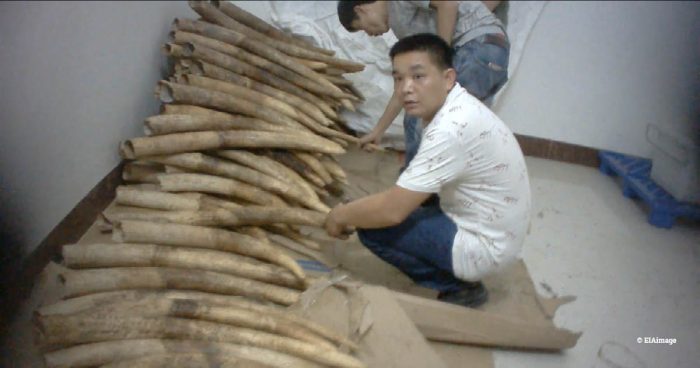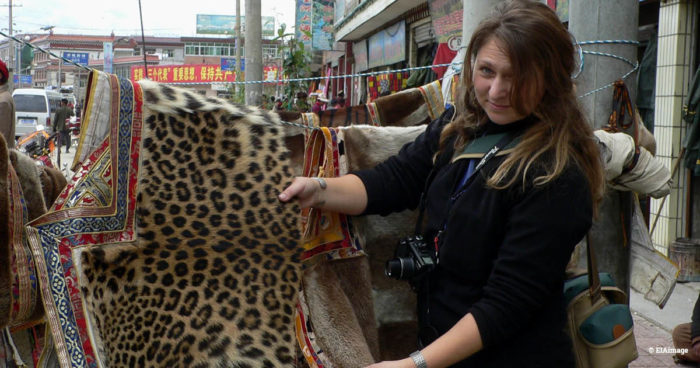Wildlife Week: Innovation and courage in the fight against wildlife crime


“If anyone finds out I’ve talked to you, I’ll be dead.”
These words, muttered nervously in a crowded London pub in February 1987, proved to be the inception of our game-changing Elephant Campaign.
The speaker was an anxious veteran seaman and, squeezed in at the table with him, were Allan Thornton and Dave Currey, two of our co-founders.
The young environmentalists, fresh from their recently formed NGO’s early successes exposing pilot whaling in the Faroe Islands and the international trade in wild-caught birds, had been told by a mutual contact that the merchant sailor had a story about ivory poaching that “might interest” them.
It did, and what they heard at this clandestine meeting would lead into EIA’s first investigation into the illegal ivory trade and eventually take them to the United Arab Emirates to document huge shipments of poached ivory from the killing fields of Africa being smuggled to a carving factory in Dubai.
As well as our first ivory investigation, it also delivered one the most iconic images to be associated with our work when, unable to access or film in the carving factory, cameraman Clive Lonsdale was hidden in a cardboard box – complete with a hastily cut viewing slot – and raised on a forklift truck in a helpful neighbouring premises so he could see down into the ivory carving operation and capture the proof needed to make the case. In honour of the vital footage Clive secured, one of the fake companies subsequently created for use in our undercover investigations was named Box Films.
The findings in the UEA and subsequent investigations formed the 1989 report A System of Extinction: The African Elephant Disaster which, released on the eve of a key meeting of the Convention on International Trade in Endangered Species of Wild Fauna and Flora (CITES) in Switzerland, exposed the ivory syndicates in China, Dubai and Africa behind the slaughter which had contributed to the catastrophic reduction by half of Africa’s elephant population in one short decade.
We were one of the first organisations to call for a worldwide ivory trade ban and worked with Tanzania to secure the CITES Appendix I listing for all elephants. The report and its explosive findings triggered the 1989 global ban on international ivory trade, one of the greatest conservation successes of the 20th century.

Illegal ivory caught on hidden camera in Shuidong, China
A System of Extinction was the beginning of our work for elephants but by no means the end of it; in 2000, we were back at CITES to warn Parties that their one-off sale of stockpiled ivory was spurring renewed elephant poaching, 2010’s Open Season exposed major flaws in bids by Tanzania and Zambia to sell their stockpiled ivory, 2014’s Vanishing Point revealed how Chinese-led criminal gangs conspired with corrupt Tanzanian officials to traffic huge amounts of ivory and 2017’s The Shuidong Connection exposed a major ivory-trafficking syndicate in China – all while we continued to vigorously campaign for the closure of domestic ivory markets around the world.
In 1993, after documenting tiger parts in trade during the course of our rhino investigations, we threw our weight behind efforts to save the tiger, with testimony contributing to US President Bill Clinton’s Interagency Task Force, set up to manage US sanctions against China and Taiwan over illegal trade in tiger bone and rhino horn.

Debbie Banks investigates big cat skin trade in Asia
In 1996 we launched our Tiger Campaign, which pulled together observations of tiger trade globally but focused on the threat posed to wild tigers in their stronghold, India. Against the backdrop of a severe lack of political will at the highest levels, the integrity of protected areas was being eroded, poaching was being covered up and numerous recommendations from Government and expert committees was being ignored.
Since then, one exposé after the next revealed the corruption, negligence and complacency at the root of tiger poaching and trafficking. We also revealed the destruction of tiger forests at the hands of industry and business masquerading as “development” and exposed the trans-Himalayan trafficking routes for big cat body parts.
Together with our long-time partner the Wildlife Protection Society of India (WPSI), we were the first to document the true scale and nature of the illegal trade in tiger, leopard and otter skins and the demand across the Tibetan plateau.
Following the release of shocking images and information in 2005, there was a dramatic response from governments, NGOs and religious leaders, and appeals by the Dalai Lama in 2006 led to Tibetans burning skins used in traditional ceremonial garments; this was followed by a marked decline in demand and use of skins among Tibetans. Sadly the use of skins, bones, teeth and claws among Chinese buyers has persisted.
Although our Wildlife campaigns focus primarily on elephants and tigers, we have also worked to end criminal trade in other species as the need and opportunities have arisen.
As mentioned above, in 1986, at least 20 million birds were being taken from the wild in Senegal alone. Four out of every five died on the journey to the end markets so we persuaded international airlines such as British Airways to stop carrying wild-caught birds for the pet trade – more than 150 airlines followed suit and the wild bird trade collapsed. In the USA, as the investigators who revealed the horrors of the wild bird trade, we were part of a negotiating team which developed the Wild Bird Conservation Act of 1992, reducing imports from 800,000 to 40,000 wild birds and giving a legislative basis to all campaigns that followed.
Similarly, in the mid-’90s we exposed the extent of the illegal trade in turtle shells in Sri Lanka and a British TV documentary highlighting our findings resulted in the governments of Sri Lanka and the Maldives cracking down.
In the early 1990s, our investigators revealed the horrific conditions for Asian bears kept captive and milked for stomach bile in China and South-East Asia, as well as the poaching of bears in Canada and the US to supply Asian consumer demand. Bears were back on our agenda in 2004; in partnership with others, we helped secure an EU import ban on grizzly bear parts, most commonly hunting trophies, from Canada and persuaded the government of British Columbia to enact a temporary ban on grizzly hunting.
Most recently, last September saw the launch of our pangolin project. During our investigations into illegal wildlife trade during the past decade, we identified a swiftly accelerating illegal trade in this shy, scaled ant-eater and, appalled to see it swiftly become the world’s most trafficked mammal, decided to put our unique methodology and considerable experience to work on its behalf.
Your support combined with the bravery and tenacity of our campaigners have made us a formidable force for wildlife criminals to reckon with – and we have no plans to do anything but increase the pressure as we move into the future.